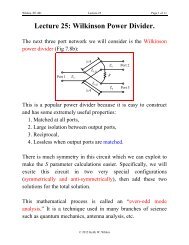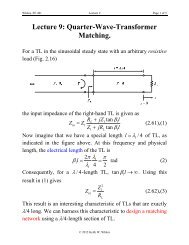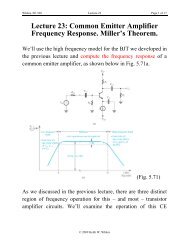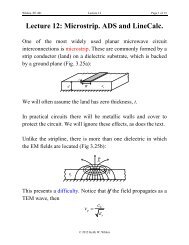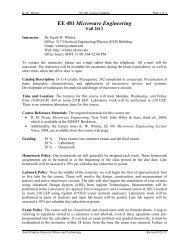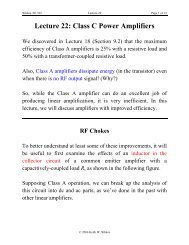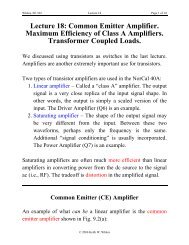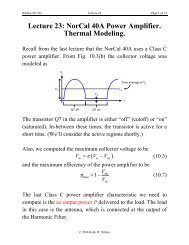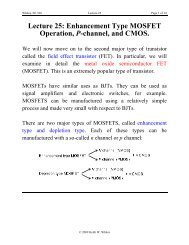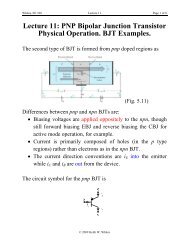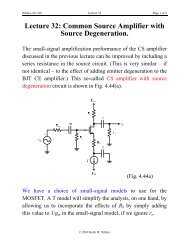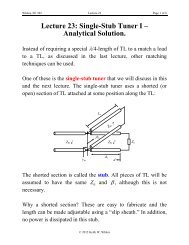Misra
Misra
Misra
Create successful ePaper yourself
Turn your PDF publications into a flip-book with our unique Google optimized e-Paper software.
8 IEEE TRANSACTIONS ON MICROWAVE THEORY AND TECHNIQIJES, VOL. 38, NO. 1. JANXJARY 1990<br />
Noninvasive Electrical Characterization of<br />
Materials at Microwave Frequencies Using<br />
an Open-Ended Coaxial Line: Test of an<br />
Improved Calibration Technique<br />
DEVENDRA MISRA, MEMBER, IEEE, MOHINDER CHABBRA, BENJAMIN R. EPSTEIN, SENIOR MEMBER, IEEE,<br />
MARK MIROTZNIK, STUDENT MEMBER, IEEE, AND KENNETH R. FOSTER, FELLOW, IEEE<br />
Abstract -We consider dielectric measurements using a probe consist-<br />
ing of coaxial transmission line with an open-circuit end placed against the<br />
sample. For the 2.99 or 3.6 mm (OD) probes considered in this study, a<br />
simple lumped parameter model shows errors above 1 GHz that increase<br />
greatly with frequency. We evaluate an approximate model due originally<br />
to Marcuvitz, on the basis of measured probe impedances from 1 to 18<br />
GHz with samples consisting of water, methanol, and dioxane-water<br />
mixtures. This model is more accurate than the lumped-parameter model,<br />
and is better suited for calibration of the automated network analyzer.<br />
Finally, we consider the errors introduced in dielectric measurements by<br />
the use of approximate models for the probe. The technique succeeds<br />
because of partial cancellation of errors in modeling the probe in ANA-<br />
based measurements.<br />
EVERAL AUTHORS have described the use of open-<br />
S ended coaxial transmission lines as sensors for measurement<br />
of the complex permittivity E of materials at<br />
microwave frequencies [lj-[6]. The probe (typically a length<br />
of the common 3.6 mm OD semirigid line) is placed<br />
against the sample and its complex reflection coefficient I'<br />
is measured with an automated network analyzer (ANA).<br />
The ANA is calibrated by measuring the reflection coefficient<br />
of the line with known loads, typically open and<br />
short circuits and a reference liquid such as water. A good<br />
electrical model for the probe is needed, both to calibrate<br />
the ANA and to calculate the dielectric properties of the<br />
sample from the probe admittance.<br />
In the limit of low frequencies, the admittance Y of the<br />
probe is given by a lumped-parameter model:<br />
Y = C, + joCj(ct- jc") (1)<br />
where C, and Cf are constants that depend on the dimen-<br />
sions of the probe, w is the frequency (rad/s), and c = c'-<br />
jr" is the complex permittivity of the sample.<br />
As the frequency is increased, this model fails because of<br />
the presence of higher order modes at the aperture and (at<br />
still hlgher frequencies) because of radiation effects. While<br />
no rigorous closed-form solution exists, several approxi-<br />
mate solutions are available. Marcuvitz expressed the ad-<br />
mittance of a probe as an integral over its aperture [7]; this<br />
approximation was rederived in equivalent forms by Levine<br />
and Papas [8] and <strong>Misra</strong> [9]. Marcuvitz's approximation<br />
can be expanded in a series that is convenient for numeri-<br />
cal solution, and in this form has been used in experimen-<br />
tal studies employing the probe technique [lo]. Alterna-<br />
tively, the probe admittance can be numerically calculated<br />
using the mode-matching technique [ll]. This method ex-<br />
plicitly takes higher order modes into account and is more<br />
accurate but too time-consuming for microcomputer-based<br />
measurements.<br />
As shown below, Marcuvitz's approximation is only a<br />
modest improvement over the lumped-parameter model<br />
for the probes considered here. However, for ANA-based<br />
measurements it significantly enhances measurement accu-<br />
racy. The reason, apparently, is a cancellation of errors;<br />
errors in calibrating the ANA are partially compensated<br />
by subsequent miscalculation of the permittivity from the<br />
(mismeasured) admittance. (The ANA is still miscali-<br />
brated, however, which might lead to imperfect cancella-<br />
tion of resonance-type artifacts [12].)<br />
Manuscript received February 10, 1989; revised August 21, 1989. This<br />
11. THEORY<br />
work was supported by the National Science Foundation under Grant<br />
ECS-8717857 (D. <strong>Misra</strong> and M. Chabbra), by the National Institutes of<br />
Health under Grant CA26046, and by the Office of Naval Research<br />
The two equivalent formulations for the admittance of<br />
the line are<br />
under Contract N00014-86-K-0240 (K. R. Foster and M. Mirotznikl.<br />
D. <strong>Misra</strong> and M. Chabbra are with the Department of Electrical<br />
Engineering and Computer Science, University of Wisconsin, Milwaukee,<br />
WI 53201.<br />
k2y, exp(- jkr)<br />
y = j nkc ln(b/a) ffPs4' r d@'dpldp<br />
B. R. Epstein is with the David Sarnoff Research Center. Inc. Princeton,<br />
NJ 08540.<br />
M. Mirotznik and K. R. Foster are with the Department of Bioengi-<br />
,-\<br />
(2)<br />
neering, University of Pennsylvania, Philadelphia, PA 19104-6392.<br />
IEEE Log Number 8931564.<br />
where r = {p2 + pr2 - 2pPf cos c$')(~/~) and = 0.02S, the<br />
0018-9480/90/0100-0008$01.00 01990 IEEE
MISRA et ~ 1.: NONINVASIVE ELECTRICAL CHARACTERIZATION OF MATERIALS 9<br />
TABLE I TABLE I1<br />
PARAMETERS FOR THE COAXIAL TRANSMISSION LINES DISPERSION PARAMETERS USED WITH EQ. (4) TO CALCULATE<br />
USED FOR THIS STUDY THE DIELECTRIC PROPERTIES OF THE FLUIDS USED IN THIS STUDY<br />
1, -4.37 (-12) -3.86 (-13)<br />
The outer diameter (0.d.) is nominal only and used for reference in the<br />
discussion in the text.<br />
Exponents are indicated in parentheses.<br />
characteristic admittance of the line (from <strong>Misra</strong>). In addi-<br />
tion,<br />
Y=G+ jB<br />
-<br />
Yodc<br />
G=<br />
ln(b/a)&<br />
/(v'2'_8<br />
o<br />
1<br />
[ J0(k,&b sin 13)<br />
- Si (2k,&a sin (8/2))<br />
- Si (2k,&h sin (8/2)] dB<br />
(from Marcuvitz). In these expressions, a and b are the<br />
inner and outer radii of the line (Table I); ko is the<br />
propagation constant in free space, 27rf/c, where c is the<br />
velocity of light in vacuum and f the frequency; r and c,<br />
are the relative permittivities of the material under test and<br />
the dielectric in the transmission line, respectively; Jo is<br />
the Bessel function of order zero; and Si is the sine<br />
integral.<br />
These results are approximate in several respects: they<br />
were derived assuming the presence of an infinite conductive<br />
flange over the aperture (not present with the coaxial<br />
lines), and they do not explicitly account for higher order<br />
modes at the aperture. In addition, the properties of any<br />
real probe will vary because of manufacturing tolerances.<br />
In this study we evaluated (2) and (3) numerically, using<br />
either a series expansion or numerical integration. The<br />
Appendix contains a series expansion that is valid for the<br />
frequency range and probe dimensions used in this study.<br />
(Fewer terms in this expansion are reported in [lo].) In the<br />
lumped-parameter model, the parameter C' corresponds to<br />
Substance<br />
water<br />
80% water- 3.75 61.9 1.1 0<br />
20% dioxane<br />
60% water- 3.35 44.5 1.5 0.1<br />
40% dioxane<br />
40% water- 3.1 27.2 1.7 0.1<br />
60% dioxane<br />
20% water-<br />
80% dioxane<br />
dioxane 2.2 2.2 - -<br />
methanol 5.6 32.6 4.8 0<br />
Values for water and methanol from [14].<br />
For the dioxane-water mixtures, r, was obtained from 1151 and the<br />
dispersion parameters for these solutions estimated by interpolation from<br />
1161.<br />
- Temperature is 25°C.<br />
the term B1 in the Appendix, divided by the frequency; Co<br />
is small and is neglected for present purposes.<br />
For the experiments, probes were constructed from<br />
lengths of semirigid 50 &? coaxial line (3.6 mm OD line<br />
with a type SMA connector, or 2.99 mm OD precision line<br />
with a precision type K connector) ranging in length from<br />
9.5 to 14 cm. The end distal to the connector was ma-<br />
chined flat and polished with fine crocus cloth. The 2.99<br />
rnm line and K connector have considerably higher preci-<br />
sion than 3.6 mm line and SMA connector, and were used<br />
for most of the measurements discussed below.<br />
The reflection coefficients of the probes were measured<br />
from 0.1 to 18 GHz using a Hewlett-Packard model 8510<br />
ANA. For these measurements, the ANA was calibrated<br />
using the normal factory-standard calibration loads (short<br />
circuit, open circuit, 50 &? sliding and fixed loads) at the<br />
end of a length of precision flexible test cable. A probe<br />
was then connected to the test cable, taking care not to<br />
flex the cable. The reference plane of the measurement was<br />
defined by shorting the end of the probe with aluminum<br />
foil and adjusting the electrical delay of the ANA until a<br />
constant 180" phase angle was observed. The small reflec-<br />
tion from the connector on the coaxial line was removed<br />
using the time-domain gating feature of the ANA. In this<br />
procedure, the measured reflection coefficients were trans-<br />
formed into the time domain, the connector reflection was<br />
electronically gated out, and the data were then trans-<br />
formed back into the frequency domain.<br />
Measurements were conducted from 0.1 to 18 GHz on<br />
several reference liquids: water, methanol, and various<br />
water-dioxane mixtures. The dielectric properties of these
Eq.1 - -<br />
Eq.3 -<br />
Experimental n<br />
Water<br />
f, GHz<br />
(b)<br />
Fig. 1. Measured and calculated admittances of 2.99 mm (OD) open-<br />
ended coaxial transmission line immersed in water. (a) Real part.<br />
(b) Imaginary part.<br />
liquids are summarized by the empirical equation<br />
with parameter values summarized in Table 11. Measure-<br />
ments were conducted at 20-25 CO.<br />
Figs. 1 and 2 compare the measured admittance of the<br />
2.99 mm probe when immersed in methanol and water<br />
with Marcuvitz's approximation (eq. (3)) and the lumped-<br />
parameter model (eq. (1)). Marcuvitz's approximation<br />
works quite well for methanol over the entire frequency<br />
range of the measurements; it is less satisfactory for water.<br />
The errors in the reflection coefficient (given as the magni-<br />
tude of the difference between the measured and calcu-<br />
lated reflection coefficients) for water at 10 GHz are 0.06<br />
(Marcuvitz's approximation) and 0.14 (lumped-parameter<br />
model). For methanol at 10 GHz these errors are 0.02 and<br />
0.04 respectively. Marcuvitz's approximation is clearly an<br />
improvement over the lumped-parameter model, although<br />
the errors involved considerably exceed those of factory-<br />
standard calibration loads for ANA calibration. (Another<br />
source of error, not considered here, is the uncertainty in<br />
the dielectric properties of the reference liquids, which can<br />
be several percent at microwave frequencies.)<br />
I Eq.1 - -<br />
F" 7 -<br />
Methanol , -1<br />
0.000<br />
1.0 3.0 5.0 7.0 9.0 11.0 13.0 15.0 17.0<br />
f, GHz<br />
Fig. 2. Measured and calculated admittances of 2.99 mm (OD) open-<br />
ended coaxial transmission line immersed in methanol. (a) Real part.<br />
(b) Imaginary part.<br />
IV. CORRECTIONS TO THE MEASURED ADMITTANCE<br />
We compare the lumped-parameter model and<br />
Marcuvitz's approximation for ANA calibration. The formalism<br />
for such corrections is well known. If rM is the<br />
measured reflection from a load (the coaxial aperture<br />
terminated by the sample) whose true reflection coefficient<br />
is rL,<br />
where A = Sl1S2, - S2,S12 and {S,,) are the elements of<br />
the scattering matrix representing the two-port network.<br />
The elements of S can be found from measurements on<br />
three standard loads.<br />
Equation (5) can be used to derive an alternate formula-<br />
tion:<br />
where Y, (i = 1,2,3) are the aperture admittances, and r,<br />
(i = 1,2,3) are the corresponding reflection coefficients us-<br />
ing three standard loads. This equation represents a linear<br />
fractional transformation of the reflection coefficient to<br />
the admittance, based on the invariance of the cross ratio<br />
in (6).<br />
To test this approach, we used (6) with experimental<br />
data to calculate the dielectric properties of water-dioxane
MlSRA et (11.: NONINVASIVE ELECTRICAL CHARACTERIZATION OF MATERIALS 11<br />
TABLE I11<br />
CALCULATED PERMITTIVITIES OF WATER-DIOXANE SOLUTIONS,<br />
USING CORRECTION METHODS DESCRIBED IN THE TEXT<br />
Solution Frequency 6 L 6 E'<br />
GHz (Eq. 1) (Eq. 2) (Lit. )<br />
I<br />
60% water- 1 44- j5 44- j4 43- j5<br />
40% 3 39- jl0 39- jll 39- jll<br />
dioxane 10 27- j12 22- j18 25- j18<br />
18 17- j9 16- j16 16- j16<br />
f, GHz<br />
40% water-<br />
60%<br />
1<br />
3<br />
26- j3<br />
22- j6<br />
26- j3<br />
23- j7<br />
26- j3<br />
23- j7<br />
(a)<br />
dioxane 10<br />
18<br />
15-j6<br />
10-j3<br />
12- j10<br />
8- j7<br />
14- j10<br />
9- j9 60 ,<br />
20% water- 1 11- jl 11- jl 11- jl<br />
80% 3 10- j2 10- j3 10- j3<br />
dioxane 10 7-jl 6- j3 7- j3<br />
18 5+j0.5 5- j3 5- j3<br />
100<br />
80 --<br />
.- - - -20% dioxane act ---methanol act. - -water act.<br />
A -20% dioxane calc. A -methanol calc.<br />
80% water- 1 64- j4 63- j4 62- j4<br />
20% 3 63- j12 58- j12 60- j12 40 --<br />
dioxane 10 45-j24 40- j26 43- j27<br />
18 23- j20 28- j28 27- j28<br />
20-- I<br />
The reference standards consisted of data obtained with the 2.99 mm<br />
probe immersed in water, methanol, and dioxane. The literature values<br />
were calculated using eq. (4). with the parameters given in Table 11.<br />
Rml Part (Eq. 2) + 1m.o. Part (Eq. 2)<br />
* Dlmpmralon Eq.(nal) -+ DIa~ermlon Eq.(lmag)<br />
Frequency in GHz<br />
Im8glnary h rt<br />
1"<br />
Fig. 3. Real and imaginary parts of the permittivity of methanol, mea-<br />
sured with a 3.6 mm coaxial probe, calculated using eq. (2), compared<br />
with literature values. The calibration loads were open and short<br />
circuits and water.<br />
mixtures. The inputs consisted of measured reflection coef-<br />
ficients from 2.99 mm probes in water, methanol, and<br />
dioxane (I?,, I?, I?, used for calibration) and water-di-<br />
oxane mixtures. For each water-dioxane mixture, the cor-<br />
rected probe admittance was obtained from (6). The per-<br />
mittivity of the sample was then found by solving (3)<br />
iteratively using the series expansion in the Appendix. The<br />
lumped-parameter model appears to introduce substantial<br />
errors in the loss (the imaginary part of c"), as shown in<br />
Table 111. Marcuvitz's approximation reduces these errors.<br />
Finally, the correction method was applied to data ob-<br />
tained from a probe made from 3.6 mm semirigid coaxial<br />
line, whose connector (type SMA) had a high reflection<br />
coefficient of about 0.05 at 10 GHz. The calibration loads<br />
consisted of an open and a short circuit and water; mea-<br />
surements were performed on 0.3 N NaCl and methanol.<br />
The results for methanol are shown in Fig. 3. The sug-<br />
gested calibration procedure eliminates noticeable oscilla-<br />
tory behavior due to connector artifacts.<br />
- - -20% dioxane act -- -methanol act - - water act.<br />
,, A -20% diaxane calc A -methono1 colc<br />
f, Gtiz<br />
Fig. 4. (a) Real part and (b) imaginary part of the permittivity of three<br />
liquids (water, methanol, 20 percent dioxane-80 percent water), show-<br />
ing effects of miscalibration of ANA due to the use of lumped-parame-<br />
ter model (eq. (1)) for the probe. The calculations assume a 2.99 mm<br />
probe, with calibration standards consisting of open and short circuits<br />
and water.<br />
Several authors (notably, Stuchly and coworkers [2]-[4])<br />
have reported extensive measurements on tissues using 3.6<br />
mm probes at frequencies up to 10 GHz. (In most cases,<br />
the ANA was calibrated from measurements on the probe<br />
when shorted, open-circuited, and immersed in water.)<br />
Despite the use of the lumped-parameter model, they<br />
achieved high accuracy in their measurements.<br />
To explore this further, we simulated the effects of<br />
miscalibration of the ANA that would result from using<br />
the lumped parameter model. Simulated calibration data<br />
were obtained for an open and a short circuit (I? = + 1 and<br />
- 1, respectively), and for the probe immersed in water<br />
(with r calculated from (3)). The assumed reflection coeffi-<br />
cients for these measurements were + 1 and - 1, and the<br />
probe reflection coefficient from water was calculated on<br />
the basis of (1). Then, the elements of the presumed<br />
"scattering matrix" for system errors (which actually rep-<br />
resent errors due to the lumped-parameter model) were<br />
calculated using (5) and used to "correct" the reflection<br />
coefficients from several liquids that had been calculated<br />
using (3). Finally, the dielectric properties of the liquids<br />
were calculated using (1).
12 IEEE TRANSACTIONS ON MICROWAVE THEORY AND TECHNIQUES, V01.. 38, NO. 1, JANUARY 1990<br />
The results of this simulation are shown in Fig. 4. The<br />
permittivity values (c') are remarkably accurate. In con-<br />
trast, the loss (€") is underestimated above a few GHz, by<br />
about 20 percent for the water-dioxane mixture at 10<br />
GHz, and by much larger fractions for the methanol. The<br />
previous studies [2]-[4] used a reference liquid (water) that<br />
is electrically similar to the test materials (high-water-con-<br />
tent tissues). This is likely to ensure high accuracy in the<br />
measurements, despite errors in the model of the probe. At<br />
frequencies below ca. 1 GHz, the model-dependent errors<br />
become very small and the lumped-parameter model is<br />
satisfactory.<br />
VI. CONCLUSION<br />
Marcuvitz's approximation improves the accuracy of<br />
dielectric measurements using coaxial probes and is useful,<br />
for the probes considered here, up to ca. 10 GHz. The where<br />
where<br />
probe technique succeeds because the errors in modeling<br />
the probe are partially canceled by calibration errors in the<br />
ANA. While the final measurement errors are difficult to<br />
quantify, they appear to be small if the electrical properties<br />
of the reference liquid are close to those of the sample<br />
under test or at low frequencies.<br />
In the expressions below, all dimensions are in cm and<br />
all frequencies in Hz. The probe admittance Y (in siemens)<br />
is given by<br />
Y=G(f )+jB(f)
MlSRA et 01.: NONINVASIVE ELECTRICAL CHARACTERIZATION OF MATERIALS<br />
where<br />
(This expansion, to fewer terms, is given in [lo].) The<br />
characteristic impedance of the line is 2,. Note that k( f)<br />
and K( f) are complex functions of the complex permittiv-<br />
ity r, which is defined in the Introduction.<br />
We have incorporated this series in the software to<br />
perform the probe measurements, using a Hewlett-Packard<br />
model HP8410 ANA controlled by a H-P 9836 computer.<br />
The permittivity c can be obtained from the measured<br />
admittance within about a second. Surprisingly, the solu-<br />
tion (using Laguerre's method [13]) showed no tendency to<br />
converge to a spurious root, perhaps because of the avail-<br />
ability of good initial guesses for the permittivity. For<br />
measurements using the 3.6 mm probe on water at 10<br />
GHz, all terms in this series are needed to ensure conver-<br />
gence of the series to (3) to within 1 percent. The rate of<br />
convergence of the series is extremely sensitive to the<br />
dimensions of the probe and to the frequency.<br />
[I] E. Tanabe and W. T. Joines, "A nondestructive method for measur-<br />
ing the complex permittivity of dielectric materials at microwave<br />
frequencies using an open transmission line resonator," IEEE Trans.<br />
Instrunz. Meus., vol. IM-25, pp. 222-226, 1976.<br />
[2] T. W. Athey. M. A. Stuchly, and S. S. Stuchly, "Dielectric proper-<br />
ties of biological substances at radio frequencies: Part I-Measure-<br />
ment method," IEEE Trans. Microwave Theory Tech., vol. MTT-30,<br />
pp. 82-87, 1982.<br />
[3] A. Kraszewski, S. S. Stuchly, M. A. Stuchly, and S. A. Symonds,<br />
"On the measurement accuracy of the tissue permittivity in uivo,"<br />
IEEE Trans. Instrum. Meas., vol. IM-32, pp. 37-42, 1983.<br />
[4] A. Kraszewski, M. A. Stuchly, and S. S. Stuchly, "ANA calibration<br />
method for measurement of dielectric properties," IEEE Trans.<br />
in st run^. Meus., vol. IM-32, pp. 385-387, 1983.<br />
[5] E. C. Burdette, F. L. Cain, and J. Seals, "In viuo probe measure-<br />
ment technique for determining dielectric properties at VHF<br />
through microwave frequencies," IEEE Trans. Microwave Theoiy<br />
Tech., vol. MTT-28, pp. 414-427,1980.<br />
[6] T. P. Marsland and S. Evans, "Dielectric measurements with an<br />
open-ended coaxial probe," Proc. Inst. Elec. Eng., vol. 134, pp.<br />
341-349, 1987.<br />
[7] N. Marcuvitz, Wuc,eguide Hundbook. New York: McGraw-Hill,<br />
1951, pp. 213-216.<br />
[XI H. R. Levine and C. H. Papas, "Theory of the circular diffraction<br />
antenna," J. Appl. Phys., vol. 22, pp. 29-43, 1951.<br />
[9] D. K. <strong>Misra</strong>, "A quasi-static analysis of open-ended coaxial lines,"<br />
IEEE Trans. Microwave Theoiy Tech., vol. MTT-35, pp. 925-928,<br />
1987.<br />
[lo] D. Xu, L. Li, and Z. Jiang, "Measurement of the dielectric proper-<br />
ties of biological substances using an improved open-ended coaxial<br />
line resonator method," IEEE Trans. Microwaue Theoty Tech., vol.<br />
MTT-35, pp. 1424-1428, 1987.<br />
[ll] J. R. Mosig, J. C. E. Besson, M. Gex-Fabry, and F. E. Gardiol,<br />
"Reflection of an open-ended coaxial line and application to non-<br />
destructive measurement of materials," IEEE Trans. Instrum.<br />
Meas., vol. IM-30, pp. 46-51, 1981.<br />
[12] K. R. Foster, B. R. Epstein, and M. A. Gealt, "'Resonances' in the<br />
dielectric absorption of DNA?", Biophys. J., vol. 52, pp. 421-425,<br />
1987.<br />
[13] W. H. Press, B. P. Flannery, S. A. Teukolsky, and W. T. Vetterling,<br />
Numerical Recipes. Cambridge, UK: Cambridge University Press,<br />
1986.<br />
[14] Tables of Dielectric Dispersion Date for Pure Liquids and Dilute<br />
Solutions, National Bureau of Standards Circular 589 (Nov. 1,<br />
1958).<br />
[15] F. E. Critchfield, J. A. Gibson, Jr., and J. L. Hall, "Dielectric<br />
constant of the dioxane-water system," J. Amer. Cheni. Soc., vol.<br />
75, pp. 1991-1992, 1953.<br />
[16] J. B. Hasted, G. H. Haggis, and P. Hutton, "Dielectric dispersion<br />
of water-dioxane mixtures," Trans. Farads?, Soc., vol. 47, pp.<br />
577-580, 1951.<br />
Devendra <strong>Misra</strong> (M'74) was born in Unnao<br />
(U.P.), India, in 1949. He received the Ph.D.<br />
degree in electrical engineering from Michigan<br />
State University, East Lansing, in 1984.<br />
Since August 1985, he has been with the Fac-<br />
ulty of Electrical Engineering, University of Wis-<br />
consin, Milwaukee. Prior to this he had been a<br />
Post-Doctoral Research Associate in Electrical<br />
Engineering, Division of Engineering Research,<br />
Michigan State University. During the years<br />
1973-1980. he held research and teachine facultv<br />
positions in India. He worked as a Teaching and Research Assistant<br />
during his studies at Michigan State University. His current interests<br />
include industrial and biomedical applications of electromagnetic energy,<br />
- 2
microwave/millimeter-wave circuits, and numerical techniques in electro- In 1983 he joined the Microwave Research Laboratory at the David<br />
magnetics. Sarnoff Research Center, Princeton, NJ, as a member of the technical<br />
Dr. <strong>Misra</strong> is a member of the Optical Society of America and the staff. His work has concentrated on the development of computer-aided<br />
American Geophysical Union. design, test, and manufacturing techniques for microwave circuits and<br />
systems. Other interests include microwave circuit design and research on<br />
the biophysical mechanisms of microwave absorption by tissues.<br />
Dr. Epstein serves as chairman of the IEEE Princeton Section of the<br />
MTT/ED/AP Societies.<br />
Mohinder Chabbra recently graduated from the<br />
University of Wisconsin, Milwaukee with a master's<br />
degree in electrical engineering. He received<br />
a bachelor's degree in electrical engineering from<br />
the Faculty of Engineering, D.E.I., India, in July<br />
1987.<br />
He is now a Member of Technical Staff at<br />
AT&T Bell Laboratories, Indian Hill, Naperville,<br />
IL. His current areas of interest include software<br />
development for digital interfaces and highfrequency<br />
measurements. He intends to pursue a<br />
Ph.D. degree in electric :a1 engineering.<br />
Benjamin R. Epstein (S'76-M'82-SM'87) received the BSE degree in<br />
electrical engineering from the University of Rochester (1979) and the<br />
MSE and Ph.D. degrees in bioengineering from the University of Penn-<br />
sylvania (1980 and 1982, respectively). His Ph.D. dissertation was on the<br />
microwave dielectric properties of microemulsions. During the years<br />
1982-83 he served as a postdoctoral fellow at the Centre National de la<br />
Recherche Scientifique, Paris, France.<br />
Mark Mirotznik (S'86) was born in Sycamore,<br />
IL, in 1965. He received the B.S. in electrical<br />
engineering from Bradley University, Peoria, IL,<br />
in 1988. He is presently a candidate for the<br />
Ph.D. degree in bioengineering from the Univer-<br />
sity of Pennsylvania.<br />
Kenneth R. Foster (M'77-SM'81-F'88) was<br />
born in Baltimore, MD, in 1945. He received the<br />
Ph.D. degree in physics from Indiana University,<br />
Bloomington, in 1971.<br />
He served as a Lieutenant, Medical Service<br />
Corps, U.S. Navy, at the Naval Medical Re-<br />
search Institute, doing research on the interac-<br />
tions between nonionizing electromagnetic radia-<br />
tion and biological systems. Since 1976 he has<br />
been with the Department of Bioengineering of<br />
the University of Pennsylvania, where he is now<br />
Associate Professor. His research interests are in the area of mechanisms<br />
of interaction between nonionizing radiation and biological systems, and<br />
dielectric properties of heterogeneous systems.<br />
Dr. Foster is a registered professional engineer in Pennsylvania. He is a<br />
member of the AdCom of the IEEE Engineering in Medicine and Biology<br />
Society.



